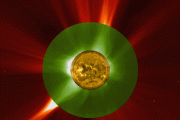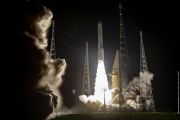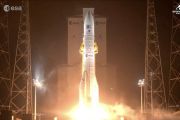
Copernical Team
Unwrapping Uranus and its icy moon secrets
 Uranus, the seventh planet from the Sun, orbits in the outer solar system, about two billion miles (3.2 billion kilometers) from Earth. It is an enormous world - quadruple the diameter of Earth, with 15 times the mass and 63 times the volume.
Unvisited by spacecraft for more than 35 years, Uranus inhabits one of the least explored regions of our solar system. Although scientists have learn
Uranus, the seventh planet from the Sun, orbits in the outer solar system, about two billion miles (3.2 billion kilometers) from Earth. It is an enormous world - quadruple the diameter of Earth, with 15 times the mass and 63 times the volume.
Unvisited by spacecraft for more than 35 years, Uranus inhabits one of the least explored regions of our solar system. Although scientists have learn Farewell, Solar Conjunction 2023: Sols 4023-4024
 Earth planning date: Wednesday, November 29, 2023: Mars has just emerged from its solar conjunction period, when sending commands to all Mars spacecraft was not safe for three weeks since the Red Planet was behind the Sun as seen from Earth.
During that time, Curiosity followed a long plan of instructions covering Sols 4004-4022 which were uploaded to the rover during the week of October 3
Earth planning date: Wednesday, November 29, 2023: Mars has just emerged from its solar conjunction period, when sending commands to all Mars spacecraft was not safe for three weeks since the Red Planet was behind the Sun as seen from Earth.
During that time, Curiosity followed a long plan of instructions covering Sols 4004-4022 which were uploaded to the rover during the week of October 3 Chang'e 5 lunar samples put on display in Macao
 Lunar samples retrieved by China's Chang'e 5 robotic mission went on display in Macao on Tuesday, marking the first time any lunar samples have been brought to the city for public exhibition.
The samples, contained in a specially built glass case and closely guarded, can be viewed by members of the public at the Macao Science Center until next Saturday.
The appearance of the lunar ma
Lunar samples retrieved by China's Chang'e 5 robotic mission went on display in Macao on Tuesday, marking the first time any lunar samples have been brought to the city for public exhibition.
The samples, contained in a specially built glass case and closely guarded, can be viewed by members of the public at the Macao Science Center until next Saturday.
The appearance of the lunar ma Evolving material, not rings, circling Centaur Chiron
 Observations during a stellar occultation detected the presence of evolving material orbiting around Centaur (2060) Chiron, rather than a two- ring system interpretation, according to a paper by Planetary Science Institute Senior Scientist Amanda Sickafoose.
"We observed a star passing behind the Centaur Chiron from the 1.9-m telescope in Sutherland. We detected dips in the starlight as it
Observations during a stellar occultation detected the presence of evolving material orbiting around Centaur (2060) Chiron, rather than a two- ring system interpretation, according to a paper by Planetary Science Institute Senior Scientist Amanda Sickafoose.
"We observed a star passing behind the Centaur Chiron from the 1.9-m telescope in Sutherland. We detected dips in the starlight as it NASA, small companies eye new cargo delivery, heat shield technologies
 Two small businesses are benefitting from NASA's expertise as they develop heat shield technologies, cargo delivery systems, and new protective materials for spacecraft and space stations in the growing commercial industry of low Earth orbit operations.
The two American companies - Canopy Aerospace Inc. of Littleton, Colorado and Outpost Technologies Corp. of Santa Monica, California - rec
Two small businesses are benefitting from NASA's expertise as they develop heat shield technologies, cargo delivery systems, and new protective materials for spacecraft and space stations in the growing commercial industry of low Earth orbit operations.
The two American companies - Canopy Aerospace Inc. of Littleton, Colorado and Outpost Technologies Corp. of Santa Monica, California - rec U.S. and Saudi Arabia explore space for peaceful purposes
 The United States and Saudi Arabia have announced intentions to explore the use of outer space together in pursuit of peaceful purposes, the U.S. State Dept. announced Tuesday.
The agreement is an extension of the Jeddah Communique, a document outlining the strategic partnership between the Kingdom of Saudi Arabia and the United States signed by King Salman Bin Abdulaziz Al-Saud and Pre
The United States and Saudi Arabia have announced intentions to explore the use of outer space together in pursuit of peaceful purposes, the U.S. State Dept. announced Tuesday.
The agreement is an extension of the Jeddah Communique, a document outlining the strategic partnership between the Kingdom of Saudi Arabia and the United States signed by King Salman Bin Abdulaziz Al-Saud and Pre Satellite discovered by NASA's Lucy mission gets name
 The satellite discovered during the first asteroid encounter of NASA's Lucy mission has an official name. On Nov. 27, 2023, the International Astronomical Union approved the name "Selam", which means "peace" in the Ethiopian language Amharic, for Dinkinesh's moon.
"Dinkinesh is the Ethiopian name for the fossil nicknamed 'Lucy,'", says Raphael Marshall of the Observatoire de la Cote d'Azur
The satellite discovered during the first asteroid encounter of NASA's Lucy mission has an official name. On Nov. 27, 2023, the International Astronomical Union approved the name "Selam", which means "peace" in the Ethiopian language Amharic, for Dinkinesh's moon.
"Dinkinesh is the Ethiopian name for the fossil nicknamed 'Lucy,'", says Raphael Marshall of the Observatoire de la Cote d'Azur Was There Life on Mars
 Astrobiology is the study of the origin, evolution, and distribution of life in the Universe, and searching for life on Mars is a major goal of the Mars 2020 mission. While humans have long wondered whether there are others like us, it's only been a few decades since we've developed the technologies to search for life beyond Earth in earnest.
With space-based telescopes like James Webb, as
Astrobiology is the study of the origin, evolution, and distribution of life in the Universe, and searching for life on Mars is a major goal of the Mars 2020 mission. While humans have long wondered whether there are others like us, it's only been a few decades since we've developed the technologies to search for life beyond Earth in earnest.
With space-based telescopes like James Webb, as After 50 years, US to return to Moon on January 25
 More than 50 years after the last Apollo mission, the United States will try once again to land a craft on the Moon on January 25, said the head of what could be the first private company to successfully touch down on the lunar surface.
The lander, named Peregrine, will have no one on board. It was developed by American company Astrobotic, whose CEO John Thornton said it will carry NASA ins
More than 50 years after the last Apollo mission, the United States will try once again to land a craft on the Moon on January 25, said the head of what could be the first private company to successfully touch down on the lunar surface.
The lander, named Peregrine, will have no one on board. It was developed by American company Astrobotic, whose CEO John Thornton said it will carry NASA ins Space Team Europe for Euclid: Guadalupe Cañas Herrera
 Video:
00:03:39
Video:
00:03:39
Focus on Euclid with Guadalupe Cañas Herrera: “I’m exactly where I’ve always wanted to be.”
Guadalupe Cañas Herrera, an ESA Internal Research Fellow currently working for ESA’s Euclid mission at ESTEC, the Netherlands, describes in this interview her personal and professional trajectory.
Passionate about space since her early childhood, she has spent endless nights looking at the stars. Now, this theoretical physicist develops her activities within the Euclid Scientific Consortium to establish the quantity of dark matter and dark energy existing in the Universe.
Listen to Guadalupe for a vivid account from a vocational scientist and an ardent defender of





























